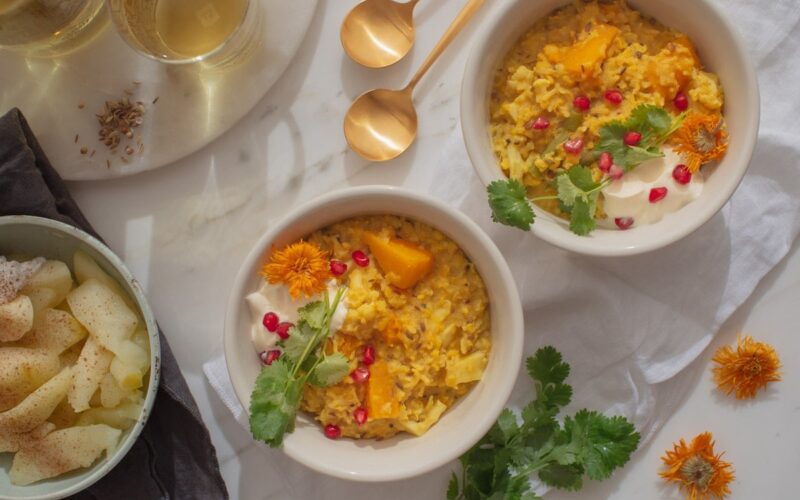Published Feb 6, 2023
Glorious Ghee
Have you ever wondered why ghee is so revered in Ayurvedic culture? Ghee (Ghritam in Sanskrit), also known as ‘golden nectar‘ or ‘liquid gold‘ is a believed to have originated in India and has been used since ancient times for many purposes, such as cooking, rituals, and healing. It is a must-have in every Ayurvedic kitchen and is also well-established in many Ayurvedic self-care practices.
Ghee is a beautiful golden yellow substance left over after the impurities of butter have been melted away. Also known as clarified butter, ghee is made by simmering butter over low heat until the milk solids and liquid fats separate. This clarification process strips away the parts of butter that are the most difficult to digest, such as lactose, casein, and whey proteins. Once the milk solids are removed you are left with ghee, a creamy, rich, clarified butter with a nutty, sweet, and caramelized flavour.
In Ayurvedic tradition, consuming ghee daily builds ojas (immunity) and nourishes depleted dhatus (tissues). Internally, ghee is traditionally considered to be nourishing for the digestive tract as it is easy to digest. It is responsible for building strong and healthy internal tissues. Ghee is a rasayana (tonic) which supports sexual organs and is also known to be an aphrodisiac in Ayurvedic culture. Due to its detoxifying benefits, it is often the core element of many Ayurvedic cleansing rituals. Ghee can be used both internally and externally and boasts numerous health benefits.
Some internal benefits and uses of ghee:
- Its unctuous quality lubricates joints and tissues, providing ease of movement and mobility.
- It helps transport nutrients in the body and release wastes out of the body.
- It facilitates movement of toxins and wastes out of the body through the digestive tract.
- Ghee is a sattvic food, which means it is abundant in prana. It supports physical strength, mental clarity, good health, longevity, and immunity.
- Ghee supports and nourishes all three doshas.
Some external benefits and uses of ghee:
- Mix with turmeric and apply topically to cuts, burns, scrapes or rashes.
- It provides long-lasting hydration which makes it a great natural moisturizer for the skin .
- It is an excellent remedy for dry, chapped lips. Mix with sugar to make a lip scrub.
- Rich in vitamins A & E, it is often used to soften hair, remove toxins, and reduce frizz.
- Mixed with sugar, lemon juice, and turmeric it can help brighten and exfoliate the skin.
- Make a rich hand cream by mixing it with equal parts coconut or almond oil.
- When combined with specific herbs and spices it can have a medicinal effect on the body. For example, mix it with Himalayan salt and use for phlegmatic coughs, mix with Hing to help reduce gas and bloating, combine with black pepper and use as a decongestant.
- It is considered one of the best substances for Abhyanga, or self-massage, increasing the overall lustre and suppleness of the body.
If you’re interested in learning more about the benefits and uses of ghee, or discovering more about Ayurveda in general, I highly recommend these reading materials:
SOMA: 100 Recipes for Self-Care
The Everyday Ayurveda Cookbook
The Everyday Ayurveda Guide to Self-Care
Here are some of my favourite ghee’s and where you can purchase them:



